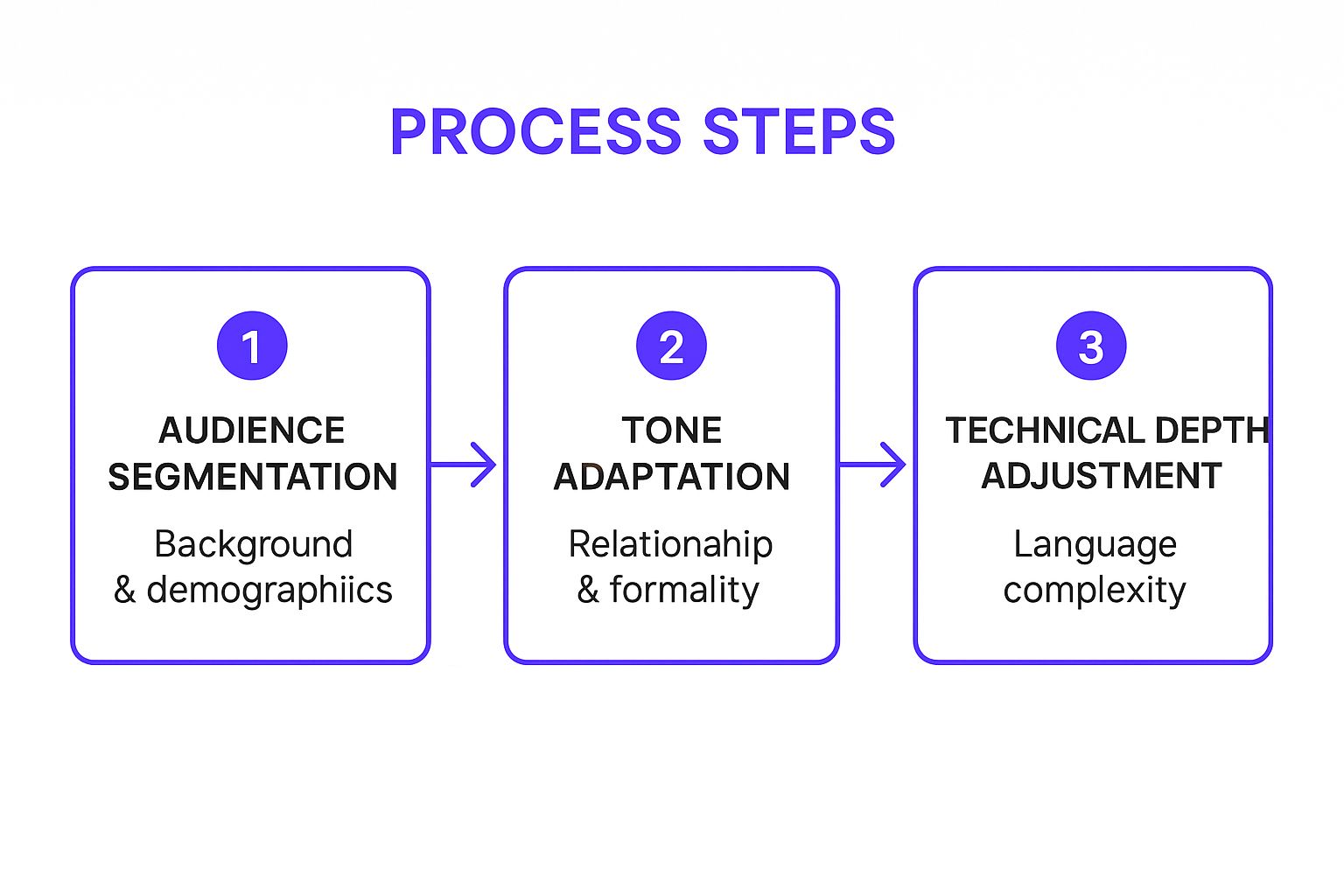9 Essential Business Writing Tips for Professionals in 2025

In today's fast-paced professional environment, the quality of your writing is your brand. From quick emails and social media updates to in-depth reports and game-changing proposals, every word you write shapes perceptions of your competence and credibility. Poorly constructed sentences, unclear requests, and a mismatched tone can lead to costly misunderstandings, stalled projects, and missed opportunities.
Conversely, mastering professional communication can accelerate your career, build stronger relationships, and drive tangible results. This guide moves beyond generic advice to offer specific, actionable business writing tips that will transform how you communicate.
You will learn powerful frameworks and proven techniques used by top-tier consultants and industry leaders. We'll explore how to write with clarity, structure your documents for maximum impact, and ensure every message you send-from a simple chat to a formal proposal-is polished and persuasive. Get ready to make every word count.
1. Write with Uncompromising Clarity and Conciseness
The bedrock of all effective business writing is the ability to convey your message with absolute clarity and brevity. This foundational skill involves stripping away unnecessary words, technical jargon, and complex sentence structures. Your goal is to use simple, direct language that ensures your audience grasps your point immediately, saving them time and preventing misunderstanding.

This principle is a cornerstone of powerful communication, as seen in Amazon's leadership principles mandating clear writing and Warren Buffett's famously direct shareholder letters. When your writing is clear, you demonstrate respect for your reader's intelligence and their schedule. This approach is non-negotiable for any communication where action or understanding is required, from a project proposal to a company-wide announcement.
How to Implement This Tip
To elevate your writing, adopt the "So what?" test. After each sentence, ask yourself if it provides essential value or moves the conversation forward. If it doesn't, cut it. This ruthless editing process is one of the most effective business writing tips for making an immediate impact.
- Simplify Your Language: Replace complex phrases with simpler alternatives. For instance, use "to" instead of "in order to," and "use" instead of "utilize."
- Keep Sentences Short: Aim for an average sentence length of under 20 words. This forces you to be direct.
- Read Aloud: Recite your text to catch awkward phrasing and run-on sentences your eyes might miss.
- Use Technology: Tools like the Hemingway Editor can instantly highlight overly complex sentences and suggest improvements.
By prioritizing clarity, you ensure your ideas are not just heard, but understood and acted upon. This skill also translates perfectly to other professional formats, as seen in these professional bio examples.
2. Know Your Audience
Understanding your audience is the compass that guides all effective business communication. This critical principle involves moving beyond a one-size-fits-all approach to tailor your message, tone, and complexity to the specific reader. Researching their background, expertise, and priorities allows you to frame your message in a way that resonates, ensuring it is not just read, but also understood and valued.
This strategy is central to influential communicators and organizations. For example, McKinsey & Company tailors its reports, creating high-level summaries for C-suite executives and detailed operational analyses for managers. This respect for the audience’s context is what separates impactful communication from noise. Adapting your writing is non-negotiable when you need to persuade, inform, or motivate a specific group, from an investor pitch to a customer service email.
How to Implement This Tip
To master this skill, start by creating a simple "audience persona" before you write. Ask yourself: Who am I writing to? What do they already know? What is their primary concern? Answering these questions is one of the most powerful business writing tips for increasing engagement and achieving your desired outcome.
- Adjust Technical Depth: Avoid jargon when writing to a non-technical audience, but use precise terminology when addressing experts who expect it.
- Consider the Medium: A formal report requires a different tone and structure than a quick Slack update or a social media post.
- Create Audience Personas: For recurring communications, develop brief profiles of key stakeholder groups (e.g., "The Busy Executive," "The Technical Specialist").
- Gather Direct Feedback: When possible, use informal conversations or brief surveys to understand your audience's communication preferences.
By customizing your message, you demonstrate empathy and strategic thinking, significantly boosting your credibility. This audience-centric approach is also fundamental to building professional relationships, a key aspect discussed in these guides on how to network online.
3. Structure with Purpose Using the SCRAP Method
A well-organized message is a persuasive one. The SCRAP method (Situation, Complication, Resolution, Action, Politeness) offers a robust framework for structuring your business writing, ensuring your ideas flow logically from context to conclusion. This structure guides your reader through your thought process, making it easier for them to understand your reasoning and the specific action required.

This logical progression, popularized by consulting firms like McKinsey & Company through concepts like Barbara Minto's Pyramid Principle, is a powerhouse among business writing tips. It forces you to clarify your thinking before you even start writing. From a project update to a complex executive briefing, this approach adds a layer of professional polish and strategic focus that commands attention and respect.
How to Implement This Tip
Before applying the full SCRAP structure, it's crucial to tailor your approach to the specific reader. The infographic above illustrates a simple three-step process for adapting your communication style: segmenting your audience, adapting your tone, and adjusting your technical depth. This initial analysis ensures your structured message resonates effectively with its intended recipient.
- Start with the Situation: Open with a clear, concise statement of the current context that everyone can agree on.
- Introduce the Complication: Describe the problem, challenge, or opportunity that disrupts the situation. This is the "why" of your message.
- Present the Resolution and Action: Clearly state your proposed solution and follow it with specific, time-bound action items. What needs to happen, by whom, and by when?
- Adapt and Practice: Use transition words to connect each section smoothly. Practice this framework on routine emails to build proficiency before applying it to high-stakes proposals or reports.
By structuring your writing with purpose, you make your communications more compelling and significantly increase the likelihood of getting the response you want.
4. Use Active Voice and Strong Verbs
Choosing active voice over passive voice is a simple change that makes your business writing more direct, engaging, and accountable. Active voice clarifies responsibility by putting the doer of the action at the forefront, creating a sense of ownership and momentum. When combined with strong, specific verbs, this technique transforms flat statements into dynamic, persuasive communication that commands attention and drives action.
This principle is about more than just grammar; it’s a reflection of leadership and clarity. Consider the difference between a passive corporate apology, "Mistakes were made," and an active one, "We made mistakes." The active version demonstrates accountability. This approach is fundamental in military communications, where clarity of command is critical, and is embodied in iconic marketing like Nike's "Just Do It," which uses active verbs to inspire millions.
How to Implement This Tip
Shifting to an active voice requires a conscious effort to identify and rephrase passive constructions. The core idea is to ensure the subject of your sentence is the one performing the action. This is one of the most powerful business writing tips for projecting confidence and authority in every email, report, or proposal.
- Spot Passive Voice: Look for forms of the verb "to be" (is, are, was, were) paired with a past participle, often followed by the word "by." For example, "The decision was made by the committee."
- Strengthen Your Verbs: Replace weak, generic verbs with precise, powerful alternatives. Instead of "The team looked at the data," write "The team analyzed the data."
- Practice Conversion: Regularly convert passive sentences to active ones. "The report was completed by Sarah" becomes "Sarah completed the report."
- Leverage Grammar Tools: Use grammar checkers like Grammarly or ProWritingAid, which can automatically flag passive sentences and suggest active alternatives.
By making active voice and strong verbs a habit, you ensure your writing is not just read but felt, prompting a clear response from your audience.
5. Lead with Key Information (Inverted Pyramid)
The inverted pyramid structure, a technique borrowed from journalism, is one of the most powerful business writing tips you can adopt. It involves placing the most critical information at the very beginning, followed by supporting details in order of decreasing importance. This approach respects your reader's limited time and guarantees your core message is delivered, even if they only skim the first few lines.
This "conclusion first" method ensures maximum impact in a world of short attention spans. It’s why executive summaries exist in reports and why effective email subject lines state the main point upfront. By leading with your key takeaway, recommendation, or call to action, you immediately answer your reader's core question: "Why should I care?" This front-loading technique is fundamental to clear, efficient communication in any professional setting.
How to Implement This Tip
To master the inverted pyramid, train yourself to write your main conclusion before you develop the supporting arguments. Start by identifying the single most important piece of information your audience needs to know and place it in the first sentence. This forces discipline and clarity into your writing from the outset.
- State the Bottom Line First: Begin emails, memos, and reports with the main point. For example, "The Q3 marketing campaign increased leads by 15%."
- Answer Key Questions Immediately: Use your opening to answer who, what, when, where, and why.
- Structure with Subheadings: Use clear, descriptive headings to guide readers through supporting details, allowing them to easily scan for relevant information.
- Prioritize Recommendations: In proposals or reports, present your recommendations before delving into the data and analysis that supports them.
This strategic ordering of information is a cornerstone of effective communication, ensuring your message is not lost. The principles are also highly relevant in broader communication strategies, as detailed in these guides to content marketing for startups.
6. Proofread and Edit Systematically
Rushing through editing is a recipe for disaster. Systematic proofreading involves a multi-pass review process, where each pass focuses on a distinct element: content, clarity, mechanics, and formatting. This methodical approach ensures professional quality and prevents embarrassing errors that can undermine your credibility and the impact of your message.
This rigorous process is standard practice in fields where precision is paramount, such as the publishing industry's multi-stage editing, the legal profession's meticulous document reviews, and corporate communication approval workflows. Adopting a similar system is one of the most effective business writing tips for elevating your work from good to great, ensuring it is polished, professional, and error-free.
How to Implement This Tip
To implement systematic editing, resist the urge to fix everything at once. Instead, create a personal checklist and review your document in focused stages. This disciplined approach is non-negotiable for high-stakes documents like proposals, reports, or external announcements where your reputation is on the line.
- Create Distance: Wait at least an hour, or ideally a full day, between writing and editing. This "cooling-off" period gives you a fresh perspective to spot errors your tired brain initially missed.
- Focus Your Passes: Dedicate separate reviews for different issues. First, check for structure and content. Next, read for clarity and flow. Finally, do a detailed pass for grammar, spelling, and punctuation.
- Read It Aloud: Reading your text out loud forces you to slow down and helps you catch awkward phrasing, run-on sentences, and typos that your eyes might otherwise skim over.
- Check for Consistency: Ensure consistent use of terminology, capitalization, and formatting (like headings and bullet points) throughout the document.
- Get a Second Opinion: Ask a trusted colleague to review important documents. A fresh set of eyes can often catch mistakes you've become blind to.
7. Choose Appropriate Tone and Formality
One of the most nuanced yet critical business writing tips is mastering the art of tone. The level of formality you choose should be a deliberate decision based on your relationship with the audience, the purpose of your communication, and your organization's culture. Getting the tone right builds rapport and conveys respect, while a misstep can undermine your credibility and damage professional relationships.
This principle is expertly demonstrated by companies like Southwest Airlines, which uses a casual, friendly tone, and IBM, known for its more professional and technical voice. The correct tone supports your message’s objective, whether you are managing crisis communications, which requires a serious and empathetic tone, or sending a routine internal update, which can be more relaxed. It shows you are socially and professionally aware.
How to Implement This Tip
To consistently strike the right chord, you must analyze your audience and context before writing a single word. Think of yourself as a conversational chameleon, adapting your communication style to fit the situation without losing your core professional identity. This adaptability is a hallmark of strong business writing skills.
- Mirror Your Audience: Observe the formality level in communications you receive from the recipient or their organization and adjust yours to match.
- Consider Emotional State: Are you delivering bad news or celebrating a win? Tailor your tone to the recipient's likely emotional reaction to be more effective.
- Use "We" and "Us": Employ collaborative language to foster a sense of partnership rather than a top-down directive.
- Err on the Side of Formal: When in doubt, it is always safer to be slightly more formal. You can always relax the tone in subsequent interactions.
Mastering this skill is fundamental to creating a consistent and effective communication style. You can develop this further by creating a comprehensive brand voice guide for your entire organization.
8. Include Clear Calls to Action
A piece of business writing without a clear directive is like a meeting without an agenda: it lacks purpose and leaves participants wondering what comes next. Every communication, whether a project update or a sales proposal, should conclude with a clear call to action (CTA). This tells the reader exactly what you want them to do, when to do it, and how to do it, eliminating ambiguity and driving results.
This principle, borrowed from direct response marketing and refined in project management, is crucial for turning passive reading into active engagement. An effective CTA transforms your message from a simple update into a catalyst for progress. Whether you're assigning tasks in a meeting follow-up or guiding a prospect toward a purchase, a strong CTA is your most important tool for ensuring action is taken.
How to Implement This Tip
To make your CTAs effective, focus on making the next step obvious and effortless for the reader. Don't make them guess what you need. Instead, guide them directly to the desired outcome with precise language and clear instructions. This is one of the most vital business writing tips for anyone looking to improve efficiency and accountability.
- Use Action Verbs: Start your request with a strong verb. Use phrases like “Please review the attached document,” “Confirm your availability by,” or “Schedule a meeting using this link.”
- Be Specific About Deadlines: Avoid vague terms like "soon" or "ASAP." Instead, provide a concrete deadline, such as "by EOD on Friday, March 15."
- Make It Easy: Remove any friction. Provide direct links for scheduling, attach necessary documents, or offer pre-filled templates to simplify the task.
- Limit to One Primary Action: Overwhelming your reader with multiple requests in a single email can lead to inaction. Focus on the single most important next step. To truly master persuasion and drive results, consider exploring advanced strategies for sales copywriting.
By integrating clear CTAs, you not only improve your communication effectiveness but also streamline workflows and learn how to attract clients more successfully.
9. Master the Art of Active Voice
Switching from passive to active voice is one of the most powerful business writing tips for creating dynamic, direct, and accountable communication. Active voice clarifies who is doing what, making your sentences more energetic and easier to understand. Instead of writing "The report was completed by the marketing team," the active version, "The marketing team completed the report," is stronger and more concise.

This approach is crucial in business where accountability and clear action are paramount. Passive voice can often sound evasive or bureaucratic, as in "Mistakes were made." Active voice, however, assigns responsibility and fosters a culture of ownership. By making the subject of your sentence the "doer" of the action, you immediately boost clarity and impact, ensuring your message is not just received but felt.
How to Implement This Tip
To master active voice, always identify the subject performing the action in your sentence and place it at the beginning. Review your drafts specifically looking for forms of the verb "to be" (is, are, was, were) followed by a past participle, a common sign of passive construction.
- Identify the Actor: Ask yourself, "Who or what is performing the action?" Make that the subject of the sentence.
- Restructure Sentences: Change "The decision was made by management" to "Management made the decision."
- Check for "by" Phrases: Sentences that include "by [the doer]" are often passive and can be easily rephrased.
- Use Editing Tools: Grammarly and other grammar checkers excel at flagging passive voice and suggesting active alternatives.
Embracing active voice is a fundamental shift that injects confidence and authority into your business writing, making you a more effective and persuasive communicator.
9 Key Business Writing Tips Comparison
| Item | Implementation Complexity 🔄 | Resource Requirements ⚡ | Expected Outcomes 📊 | Ideal Use Cases 💡 | Key Advantages ⭐ |
|---|---|---|---|---|---|
| Write with Clarity and Conciseness | Low - Focus on editing and simplicity | Moderate - Requires editing time | Clear, quick understanding; reduced miscommunication | All business writing; professional and formal communication | Improves engagement; minimizes misunderstandings |
| Know Your Audience | Moderate - Requires research and analysis | Moderate to High - Time for audience study | Higher message relevance and engagement | Tailored communications; diverse or segmented audiences | Builds relationships; increases response rates |
| Structure with Purpose (SCRAP) | Moderate - Follows defined steps | Low to Moderate | Logical flow; easier reader comprehension; action-oriented | Complex documents; proposals; recommendations | Clear structure; improves action follow-through |
| Use Active Voice and Strong Verbs | Low - Linguistic style adjustment | Low | More direct, dynamic, and accountable writing | Instructions, leadership communication, persuasive writing | Enhances clarity and accountability |
| Lead with Key Information (Inverted Pyramid) | Low to Moderate - Requires planning | Low | Quick message absorption; scannable content | Executive summaries, email subject lines, press releases | Respects reader's time; highlights priorities |
| Proofread and Edit Systematically | High - Multi-pass review process | High - Time intensive | Error-free, polished, professional communications | All important documents; legal, academic, corporate writing | Significantly improves quality and credibility |
| Choose Appropriate Tone and Formality | Moderate - Context and cultural calibration | Moderate | Builds rapport; supports objectives; reduces misinterpretation | Customer service, cross-cultural, sensitive communications | Enhances emotional intelligence and professionalism |
| Include Clear Calls to Action | Low to Moderate - Clear, specific phrasing | Low | Increased response rates; clear expectations | Project management, sales, marketing, follow-ups | Drives action; measurable outcomes |
Putting It All Together: Your Path to Better Business Writing
We’ve journeyed through a comprehensive set of strategies designed to elevate your professional communication. From understanding your audience and structuring your message with the SCRAP method to leading with the inverted pyramid and employing a systematic proofreading process, each of these business writing tips offers a powerful lever for improvement. Mastering these techniques isn't about becoming a literary genius; it's about achieving precision, clarity, and impact in every email, report, proposal, and social media update you create. The goal is to make your message so clear that it cannot be misunderstood and so persuasive that it inspires action.
From Theory to Daily Practice
The true value of these business writing tips lies in their consistent application. Information alone doesn't create change, but deliberate practice does. Don't try to implement everything at once. Instead, adopt a gradual, focused approach to build lasting habits.
- Start Small: For the next week, concentrate solely on using active voice and strong verbs in your emails. Notice how it changes the energy and directness of your messages.
- Build Gradually: Once that feels natural, add another principle. Focus on structuring your next few internal communications using the inverted pyramid, placing the most critical information upfront.
- Expand Your Scope: Apply these combined skills to larger documents. When writing your next report or proposal, consciously analyze your audience, define a clear purpose, and embed a specific call to action.
This methodical approach transforms abstract concepts into tangible skills, creating a ripple effect that enhances your professional credibility and influence.
The Broader Impact of Effective Writing
Strong business writing is a cornerstone of professional success. It builds trust with clients, prevents costly miscommunications with colleagues, and showcases your strategic thinking to leadership. When you communicate effectively, you are not just sharing information; you are demonstrating competence, respect for the reader's time, and a commitment to quality. While these tips are tailored for a business context, many of the underlying principles are universally applicable. For a broader perspective on enhancing your communication, consider actionable tips to improve your overall writing skills. Ultimately, investing time to refine this craft is a direct investment in your career trajectory, opening doors to new opportunities and solidifying your reputation as a clear, effective, and indispensable professional.
Ready to put these business writing tips into action effortlessly? MakerBox provides AI-powered tools that help you generate and optimize polished, professional content for LinkedIn and other platforms, ensuring every post is clear, engaging, and impactful. Supercharge your professional presence by visiting MakerBox today.





